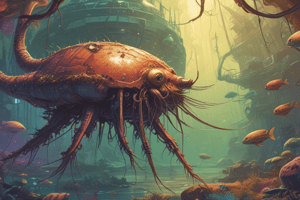Podcast
Questions and Answers
What is the function of tube feet in echinoderms?
What is the function of tube feet in echinoderms?
- Used for movement, feeding, and respiration (correct)
- Sensory perception
- Support for the body
- Protection from predators
Which class of echinoderms is characterized by a globular body and movable spines?
Which class of echinoderms is characterized by a globular body and movable spines?
- Echinoidea (correct)
- Holothuroidea
- Asteroidea
- Ophiuroidea
What is the process by which echinoderm larvae settle on the ocean floor and undergo transformation?
What is the process by which echinoderm larvae settle on the ocean floor and undergo transformation?
- Maturation
- Settlement
- Fertilization
- Metamorphosis (correct)
What is a distinctive feature of the echinoderm skeleton?
What is a distinctive feature of the echinoderm skeleton?
How do echinoderm adults reproduce?
How do echinoderm adults reproduce?
Which echinoderm class is known for its feathery arms and stalked body?
Which echinoderm class is known for its feathery arms and stalked body?
What is the main characteristic of an echinoderm's body structure?
What is the main characteristic of an echinoderm's body structure?
What is the primary function of an echinoderm's water vascular system?
What is the primary function of an echinoderm's water vascular system?
Which of the following is NOT a type of echinoderm?
Which of the following is NOT a type of echinoderm?
What is the primary source of food for echinoderms?
What is the primary source of food for echinoderms?
What is the role of echinoderms in marine ecosystems?
What is the role of echinoderms in marine ecosystems?
How do echinoderms move?
How do echinoderms move?
What is the typical body shape of echinoderms?
What is the typical body shape of echinoderms?
What is the function of the anus in echinoderms?
What is the function of the anus in echinoderms?
Which of the following classes of echinoderms includes sea stars and starfish?
Which of the following classes of echinoderms includes sea stars and starfish?
What is the process by which echinoderm larvae develop?
What is the process by which echinoderm larvae develop?
Flashcards are hidden until you start studying
Study Notes
Characteristics
- Echinoderms are a phylum of marine animals
- Characterized by:
- Radial symmetry (body organized around a central axis)
- Calcite skeleton
- Water vascular system (unique system of fluid-filled vessels)
- Tube feet (used for movement, feeding, and respiration)
Body Structure
- Body shape varies among classes, but typically includes:
- Central body (disc or sphere)
- Arms or rays ( extensions of the body)
- Mouth and anus on opposite sides of the body
- Skin and muscles are thin, allowing for flexibility
Classes of Echinoderms
- Asteroidea (Starfish or Sea Stars)
- Characterized by five-armed body shape
- Feed on clams, mussels, and snails
- Ophiuroidea (Brittle Stars)
- Characterized by long, slender arms
- Feed on small invertebrates and organic matter
- Echinoidea (Sea Urchins)
- Characterized by globular body and movable spines
- Feed on algae and small invertebrates
- Holothuroidea (Sea Cucumbers)
- Characterized by elongated, soft body
- Feed on organic matter and small invertebrates
- Crinoidea (Sea Lilies)
- Characterized by feathery arms and stalked body
- Feed on small invertebrates and organic matter
Development and Reproduction
- Echinoderms undergo indirect development (larval stage)
- Larvae settle on the ocean floor and undergo metamorphosis
- Adults reproduce sexually, releasing gametes into the water column
- Fertilization occurs externally, and larvae develop from zygotes
Studying That Suits You
Use AI to generate personalized quizzes and flashcards to suit your learning preferences.




